#Animal Model Market Trends
Explore tagged Tumblr posts
Text
Animal model Market Research Report 2024-2032

The serum-free media market has seen significant growth, driven by increasing demand for cell culture applications across industries such as biopharmaceuticals, biotechnology, and healthcare. Serum-free media, which are specifically designed to support cell growth without the inclusion of animal-derived serum, have gained widespread acceptance due to their advantages in reducing variability and ethical concerns associated with animal products.
Regional Analysis
The serum-free media market has a global presence, with notable developments in key regions such as North America, Europe, Asia Pacific, Latin America, and the Middle East & Africa. North America remains a leading market for serum-free media, driven by the region’s advanced healthcare infrastructure, research activities, and strong demand from pharmaceutical companies. Europe also holds a significant share due to an increase in biopharmaceutical research and development initiatives. The Asia Pacific region is expected to witness the fastest growth in the coming years, driven by rising investments in the healthcare and biotechnology sectors, along with growing manufacturing capabilities in countries such as China and India.
Get Free Sample Report @ https://www.snsinsider.com/sample-request/3761
Market Segmentation
By Product Type:
Classical Media
Chemically Defined Media
By Application:
Cell Culture
Vaccines
Therapeutic Proteins
Others
By End User:
Biopharmaceutical Companies
Contract Research Organizations (CROs)
Academic and Research Institutions
Others
Key Players
Key Service Providers/Manufacturers
Thermo Fisher Scientific Inc. (Gibco™ Advanced DMEM, Gibco™ CTS™ OpTmizer™ T-Cell Expansion SFM)
Merck KGaA (EX-CELL® Advanced CHO Fed-Batch Medium, Probumin-Free SFM)
Lonza Group AG (TheraPEAK™ T-VIVO™ Medium, PowerCHO™ Serum-Free Media)
Corning Incorporated (SFM4HEK293, SFM4CHO)
GE Healthcare (Cytiva) (HyClone™ SFM4CHO, HyClone™ SFM4HEK293)
HiMedia Laboratories (HyaQuil™ CHO Medium, HyaQuil™ Serum-Free Media)
Irvine Scientific (FujiFilm) (CHO-Choice SFM, PRIME-XV™ Hematopoietic SFM)
PromoCell GmbH (Serum-Free Media for Endothelial Cells, Hematopoietic Serum-Free Medium)
CellGenix GmbH (CellGenix® T Cell Medium, CellGenix® DC Medium)
Sartorius AG (CHOgro® Expression Medium, BalanCD® HEK293 Medium)
Key Service Providers/Manufacturers
Thermo Fisher Scientific Inc. (Gibco™ Advanced DMEM, Gibco™ CTS™ OpTmizer™ T-Cell Expansion SFM)
Merck KGaA (EX-CELL® Advanced CHO Fed-Batch Medium, Probumin-Free SFM)
Lonza Group AG (TheraPEAK™ T-VIVO™ Medium, PowerCHO™ Serum-Free Media)
Corning Incorporated (SFM4HEK293, SFM4CHO)
GE Healthcare (Cytiva) (HyClone™ SFM4CHO, HyClone™ SFM4HEK293)
HiMedia Laboratories (HyaQuil™ CHO Medium, HyaQuil™ Serum-Free Media)
Irvine Scientific (FujiFilm) (CHO-Choice SFM, PRIME-XV™ Hematopoietic SFM)
PromoCell GmbH (Serum-Free Media for Endothelial Cells, Hematopoietic Serum-Free Medium)
CellGenix GmbH (CellGenix® T Cell Medium, CellGenix® DC Medium)
Sartorius AG (CHOgro® Expression Medium, BalanCD® HEK293 Medium)
Key Points:
Serum-free media provides enhanced control over cell growth, differentiation, and protein production.
There is an increasing demand for serum-free media in the development of vaccines and biologic drugs.
The growing trend of biologics and personalized medicine is accelerating the need for serum-free media.
The shift towards ethical and sustainable practices in research and development is pushing the market forward.
The increasing number of government initiatives in biotechnology and pharmaceutical sectors worldwide is further fueling growth.
Future Scope
Looking ahead, the serum-free media market is poised for continued growth as the need for advanced cell culture techniques rises. With rapid advancements in biotechnology and personalized medicine, the demand for serum-free media is expected to expand, particularly in the development of cell-based therapeutics and vaccines. Moreover, with increasing regulatory pressures surrounding animal testing and product development, there will likely be a shift towards more sustainable, efficient, and ethical alternatives. This transition, coupled with ongoing innovation in media formulation and product development, will create opportunities for new market entrants and established players alike.
Conclusion
The serum-free media market is evolving rapidly, driven by technological advancements, increasing demand from biopharmaceutical companies, and the shift toward more sustainable and ethical practices in the industry. With the ongoing expansion of research and development activities globally, the market is expected to continue its growth trajectory. The future of serum-free media looks promising as it plays a crucial role in advancing cell culture techniques, therapeutics, and biologic drugs, thus reshaping the landscape of healthcare and biotechnology.
Contact Us: Jagney Dave - Vice President of Client Engagement Phone: +1-315 636 4242 (US) | +44- 20 3290 5010 (UK)
Other Related Reports:
Cell Viability Assay Market
Medical Power Supply Market
Post Traumatic Stress Disorder Treatment Market
MRI Guided Neurosurgical Ablation Market
#Animal model Market#Animal model Market Share#Animal model Market Size#Animal model Market Trends#Animal model Market Growth
0 notes
Text
Animal Model Market Outlook, Demand, Size and Research Report 2023-2028
IMARC Group, a leading market research company, has recently released a report titled “Animal Model Market: Global Industry Trends, Share, Size, Growth, Opportunity and Forecast 2023-2028.” The study provides a detailed analysis of the industry, including the global animal model market size, share, trends, and growth forecasts. The report also includes competitor and regional analysis and…

View On WordPress
#Animal Model Market#Animal Model Market Drivers#Animal Model Market Growth#Animal Model Market Size#Animal Model Market Trends#Global Animal Model Market
0 notes
Text
0 notes
Text
Meet Garima Kapoor Manocha: The Ultimate Fashion, Beauty, and Lifestyle Influencer

Garima Manocha stands out as a leading video creator and influencer, captivating her audience with vibrant content focused on fashion, beauty, and lifestyle. Here’s why Garima should be on your radar:
A Glimpse into Garima’s World
Garima’s content reflects her expertise as a model and influencer. Her social media platforms are filled with stunning visuals and valuable insights into the latest trends. She’s not just about aesthetics; Garima’s love for animals and her motivating mantra, "Never Fold, Never Back Down," add depth to her online presence.
Fashion Forward
Garima’s keen sense of style is evident in every post. She showcases the latest fashion trends, offering her followers practical advice on how to incorporate these styles into their own wardrobes. Whether it’s everyday wear or special occasion outfits, Garima has you covered.
Beauty Secrets Unveiled
Garima’s beauty content ranges from makeup tutorials to skincare routines. She shares her favorite products and beauty hacks, making it easy for her followers to look and feel their best. Her tutorials are easy to follow, making beauty accessible to everyone.
Lifestyle Insights
Beyond fashion and beauty, Garima shares lifestyle tips that resonate with her audience. From home decor ideas to wellness tips, she offers a holistic approach to living a stylish and balanced life.
Collaboration Opportunities
Brands looking to collaborate with Garima can expect professional and engaging content. She offers a range of promotional options, including Instagram Reels, stories, and static posts, all designed to maximize audience engagement and brand visibility.
Connect with Garima
For collaboration and promotion inquiries, send Garima a direct message. Stay updated with her latest content by following her on social media. Her posts are sure to inspire and entertain, providing daily doses of fashion, beauty, and lifestyle wisdom.
#Garima Manocha#Fashion influencer#Beauty influencer#Lifestyle influencer#Model influencer#Video creator#Fashion trends#Beauty tutorials#Lifestyle tips#Social media influencer#Collaboration opportunities#Brand promotions#Instagram Reels#Instagram stories#Animal lover#Beauty hacks#Influencer marketing#Engagement rates#High-quality content
1 note
·
View note
Text
A Guide to Investing Playfulness into Work Attire with Anime Clothes Hoodie
In a global where self-expression meets professional obstacles, locating the right balance may be tough. Anime clothes hoodie enthusiasts regularly find themselves torn between their love for colorful patterns and their want to keep a sophisticated look in the workplace. Worry not! With creativity and the right alternatives, you may seamlessly mix your passion for anime garments, mainly hoodies, into your expert dresser. Let’s begin an adventure of studying the art of anime-inspired fashion at work.
#elohimsaga store#anime t shirt#male model#marketing#clothingstore#trending#acne#anime clothes hoodie#menswear#finance
0 notes
Text
Follow-up to my Fanroad Magazine archival scan post - let's look at some cute 90's anime art! Just random ones that caught my eye:
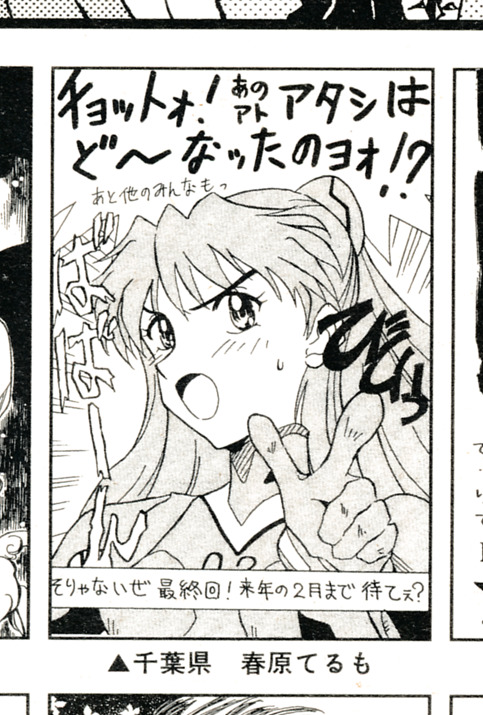
"Hey, what happened to me!?" As mentioned, this came out before End of Eva did - as such, Asuka & crew really didn't get much of an ending in the TV show. 100% how she would react to watching episode 26, props to our artist (春原てるも/Kasuhara Terumo)
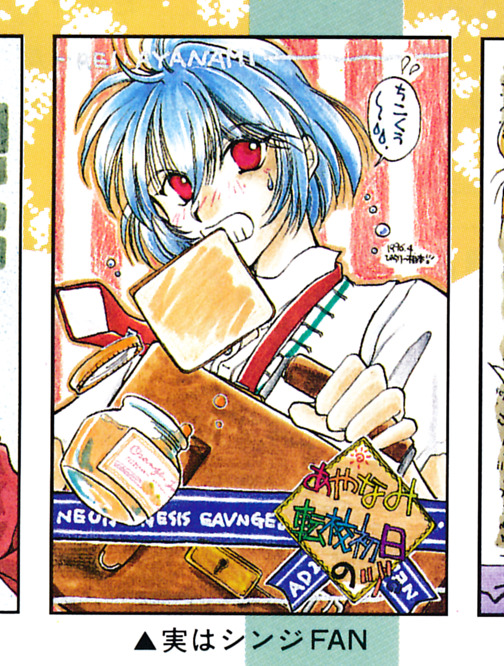
There are just so many "Rei running with toast" pieces, it was clearly a combination of a meme amoung the fans and the theme for the magazine. Love how this one brought marmalade too - never compromise on taste, no matter how late you are.
(The artist's name is "actually, I'm a Shinji fan" btw lol)
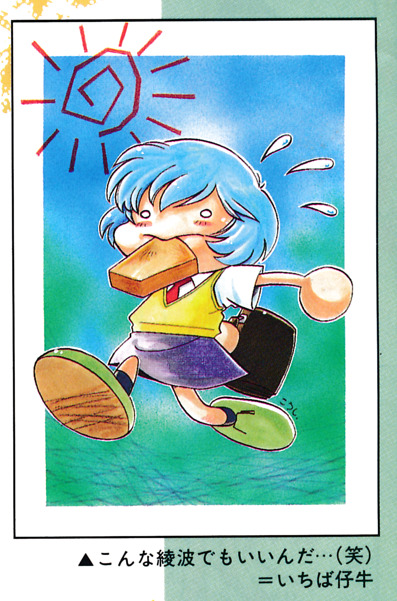
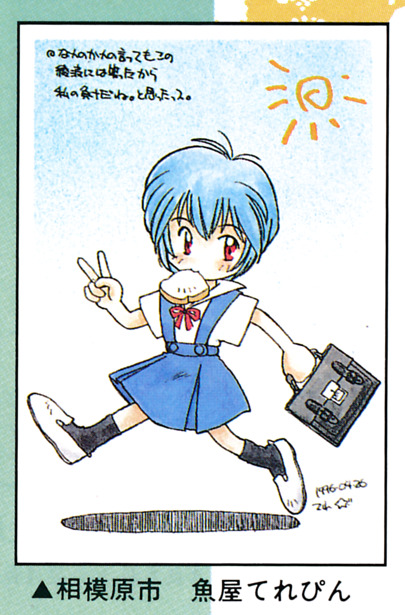
I love finds like these - these toast-lugging Rei's are by people who are professional mangaka today! The first is by いちば仔牛/Ichiba Kousei, or "Marketplace Cow" - it ain't their birth name I am sure - and they are a founding member of the doujin circle UGO - which is still going strong! And our second is by (I am 80% sure on this one) うおなてれぴん/Uona Terepin, a quite-accomplished artist who adorably published their first professional work in 1997, a year after this. Their twitter feed is 50% big titty girls and 50% model tanks, absolutely based.
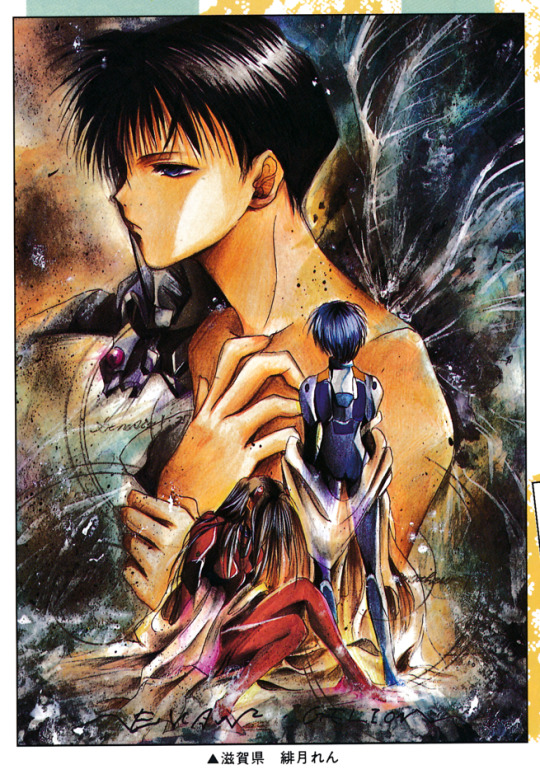
Hot👏Shinji👏Fucks👏, this piece is amazing. What else do I have to say? (緋月れん/Hizuki Ren - maybe, translating Japanese names with no context is hard guys -_-)
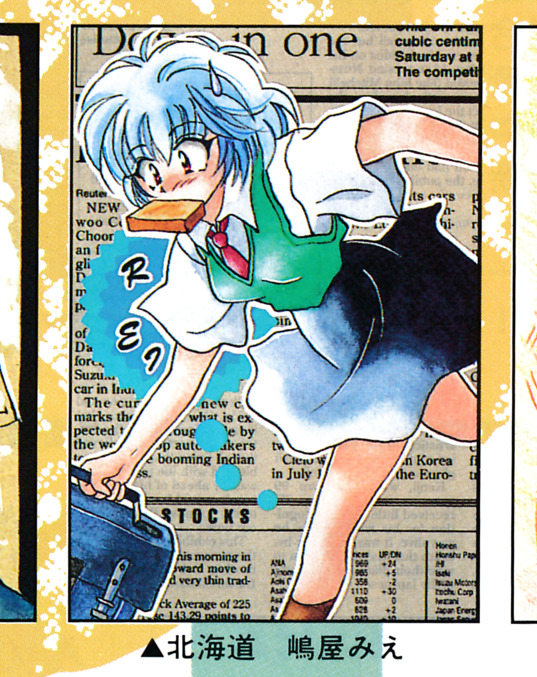
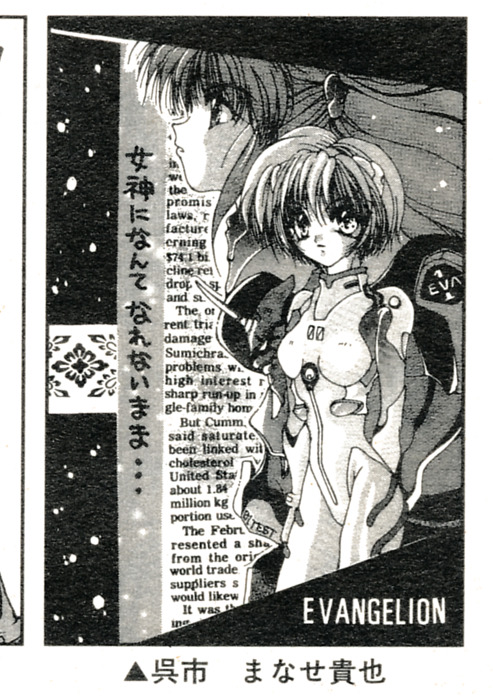
This is one of my favourite trends - so Evangelion has a lot of technobabble? And it is very frequently in English. So fans really liked recreating that aesthetic in their art. But in 1996 they didn't have access to like screengrabs from the show or scanned splatbooks on hand? Which meant they just used ~whatever English text they could find - generally newspapers at their university or library. Which means we get Toast Rei splashed on reports of stock indices in the global financial markets, and this beautiful moe-Rei/Asuka looking solemnly out over, uh, some report about housing prices and cholesterol levels? Technobabble indeed! (嶋屋みえ/Shimaya Mei, まなせ貴也/Manase Takaya)
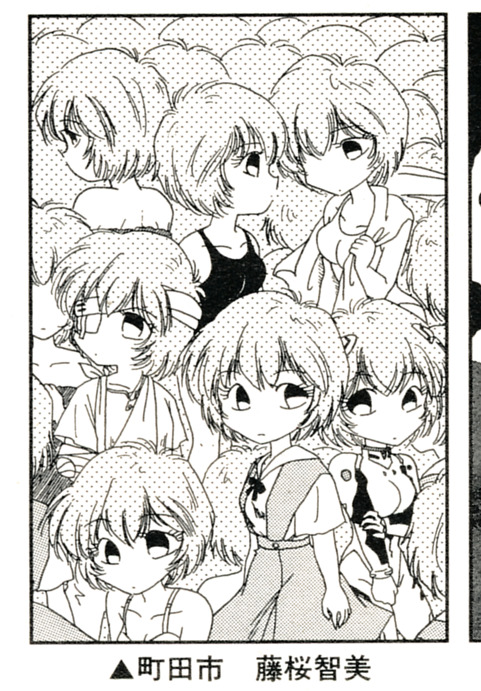
Rei clone army! Adorable. (藤桜智美/Fujisakura Tomomi)
Okay, moving away from Eva, there is in fact a bunch of other properties in here with fanart, but these types stood out to me:
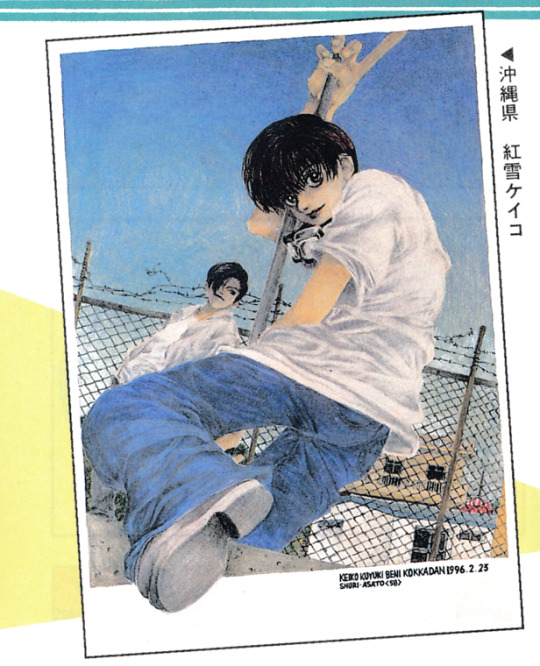
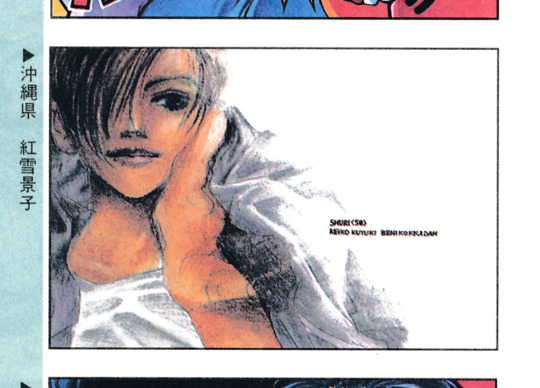
That seinen "Kids on the Street" energy that was peaking in the 90's; fully ~aesthetic. (Keiko Kuyuki)
And to end on a weird note:
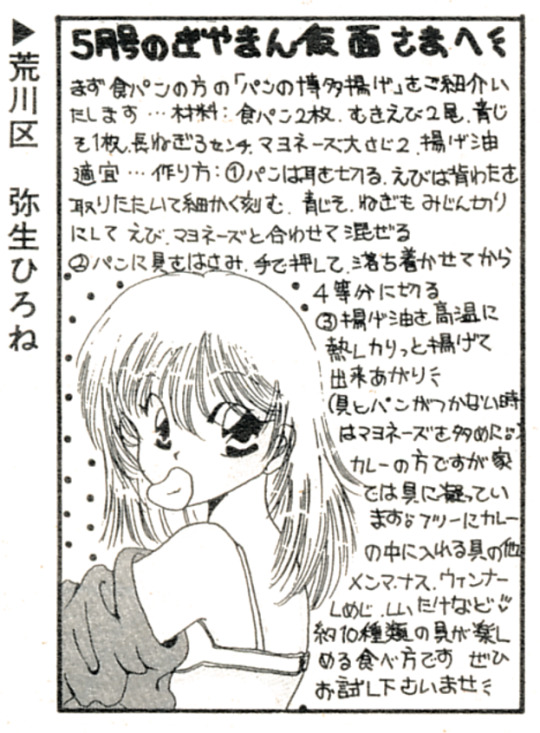
One section of the magazine is just a free-for-all of thoughts, and one Yayoi Hirone decided to give us a girl caught in the middle of undressing...alongside a recipe for cooking shrimp. Which, if I am being honest, is a huge improvement over the bullshit they throw on recipes online these days. This is the future we could have had -_-
Anyway, I hope that was fun - if anyone is struck or amused by some of the art in the magazine, I would be happy to see what stood out to you!
94 notes
·
View notes
Text
7 free startup ideas worth $1M-$1B
Customizable News Settings - A news website that generates three versions of every news story: a right-wing version, a left-wing version, and a centrist one. You can set your preferences depending on the topic - say you're right-wing on economics, but left-leaning on immigration. Or you can cycle between versions while reading an article to get a comprehensive overview of the issue at hand.
Twitch, but for Uber - With all the drama they have to deal with, independent contractors can gain a second revenue source simply by streaming their jobs. Rather than just offering rides, they can be hired to drive around performing chores and various tasks. The more outrageous the task, the more eyes they're likely to get on their stream. The more popular the stream, the more people calling in who want to be a part of the program.
Panera Lemonade, Your Way - Let the customer take control by deciding how many milligrams of caffeine they can handle. With sufficient warning about the risks, this puts the responsibility back on the consumer, allows you to upcharge for extra caffeine, and creates viral marketing from customers competing to see how high they can go. Variations of this can be created for other menu items, e.g., a version of the One Chip Challenge where the customer decides how much capsaicin to sprinkle on.
Shein, for NFTs - Whenever an NFT project hits the mainstream, there are always going to be people who miss out on being able to purchase one. This creates room in the market for 'knockoffs' - NFTs that mimic the aesthetic of the original, using similar but legally distinct AI art that uses the original set as training data, run on a parallel blockchain. Since the images themselves aren't tied to the blockchain, you can mint the NFTs beforehand and then change the image at the link to whatever happens to be in fashion at the time.
Twitch Chat Plays YouTube - Add a level quality control to AI-generated YouTube videos by allowing users to submit suggestions and vote on the results beforehand. Users can submit Wikipedia articles or movie summaries to be converted to text-to-speech, suggest keywords for the accompanying AI-generated animation, and vote on the best combinations. Users who submit winning suggestions get a portion of the ad revenue.
Buses, but Worse - The current obstacle hindering self-driving car technology is their difficulty adapting to unexpected scenarios. So instead plot a route around the city that minimizes roadway obstacles and heavy traffic, map out that route extensively to provide a model for the autopilot, and you can have a fleet of self-driving cars patrolling that circuit. Passengers can board and get off anywhere along the route.
Twitter, but for Bots - A social media platform populated entirely by bots, all programmed to maximize engagement. Memetic evolution in the wild as the bots latch on to trending keywords, spam each other with AI-generated meme images, mock up t-shirts hawking each other's designs, getting more and more degraded with each sub-iteration. Real people can't make accounts on the platform, but count for views and interactions as they stop to gawk at the virtual ecosystem. Advertisers can pay to have their brands injected directly into the discourse, like throwing a pumpkin into the polar bear cage at the zoo.
215 notes
·
View notes
Text
First off I’m a white guy but I’ve seen some discussion recently around 40K’s non-white coded factions and had some thoughts about particularly some of 40K’s old world building lore tropes and how that has influenced where we are today.
Warhammer’s planet of hats trope has lead to some really interesting cultures of planets in the Imperium in the lore. Planet of hats is essentially, how you can make lots of visually distinct cultures of worlds in a lore’s canon, making one like ancient Rome (Ultramar), one like ancient Greece (Olympia), making one like space Egypt (Prospero) or making one space scandanavia (Fenris). It’s easiest to understand it primarily as a way of differentiating the biggest money making faction in the game, Space Marines and their various chapters and legions. However, I think we also need an honest conversation about how the planet of hats trope has led to some takes on race that can be reductive and generalised on particular cultures.
For instance the Salamanders, are coded and i think intentionally to be black. You often hear fans say they’re not black in our modern understanding of race, mainly cause their skin colour is meant to be a sci-fi ultra dark because of intense radiation on their homeworld. However their geneseed (things that share particular genetic traits in Space Marine creation) also gives them red eyes which are described by some in lore as demonic looking. And the Salamanders stories often focus on this disconnect from their chapter culture, humanitarianism (by 40K standards), nobility, heroism and humility and their physical appearance which some find frightening. I think this is coded discussion of how black people face discrimination because of their appearance in many places across the world, especially when we understand that colorism and dark skinned people across all cultures often face marginalisation. This is though a really heavy handed way to discuss race I personally find it a bit on the nose.
When we look at the White Scars, who are explicitly coded as east-asian particularly Mongolian but with elements of Chinese culture thrown in, we can see that planet of hats can lead to some stereotypes and generalisations about communities being ingrained. Especially when you consider most lore authors working on Warhammer are white men.
Another example I feel is the Tau, who were created at a time when Games Workshop wanted to expand into the Japanese market, using mechs very inspired by Japanese anime and sci-fi, and as such a lot of the faction is coded with Japanese cultural and racial markers. Including the voice acting in video games, which I often find is similar to the voice acting of Samurai in movies.
I think people of colour in the Warhammer 40K community have found representation and enjoyment from these examples, but that besides, I think it highlights the cause we should broader representation on the writing and modelling in the hobby, to make a richer and more interesting world. I’ve always loved the space that Warhammer gives you to create new things in their world, seeing really incredible head-canon and fanfic for more diverse and interesting representations of characters and worlds in Warhammer. But that isn’t people’s introduction to the hobby, the Warhammer official canon and lore is. Planet of hats has lead I think to less interesting factions, by not creating and exploring more nuanced world building, which I totally concede some writers do undertake but I wouldn’t say is a general trend.
I don’t know it this is really a criticism more just a sense that Warhammer is growing as hobby, it’s bigger than it has ever been in my time playing it and this is an opportunity, to bring more people into the fandom and make our hobby inclusive.
33 notes
·
View notes
Text
0 notes
Text
i'm still holding off final judgement until the gameplay today, but seeing some stills on twitter kind of helped me solidify what i found so off-putting about the style in the companion trailer
although before i post those, a few counter arguments because i'm already tired of ppl bashing the ppl who aren't vibing with it, and my head is clear enough to put these thoughts down:
"cinematic trailers rarely look like the actual game" - true to a point. however: 1) typically cinematic trailers strive to look like a higher definition version of the game, which seems to be the opposite here. in the case of DAO and DA2, i would say the cinematic trailers actually strived for more realism, not stylization, as that was the trend at the time. 2) this is a cinematic trailer, but it is also done in the game engine so it's not unreasonable to assume that the end product is gonna look somewhat similar 3) this was supposed to be their best foot forward so suddenly going "don't worry, it's gonna look better in-game" is just a bad marketing move. it's not on the audience to give this company the benefit of the doubt (particularly in light of all the shit that has gone down there in the past decade)
"not everything has to be super realistic!" - agreed! not liking elements of this particular style doesn't mean i'm opposed to stylization in DA at all. i think DA2 is much more stylized than DAO, and not only does it look nicer, it looks more distinctly dragon age. DAO visually is also very generic, especially for its time. i still love the almost painterly look of DA2, even all these years later
and i think DAI has issues with the character models, especially the uncanny valley disconnect between the really stiff animations and realistic faces (having played it within the past year, they've aged pretty roughly), but in terms of environment and armor and whatnot, it did build off the style presented in DA2 in a way that effectively modernized it for that era. it did go for a more realistic look, but it was cohesive and still distinctly dragon age
"people reacted like this to DA2 and DAI's trailers too" - no, they did not, lmao. DA2's trailers were the reverse--they looked more realistic than the actual game. now there was some backlash against the stylistic choice in the actual game. i remember david gaider talking about it in a panel at dragon con in 2012--apparently ppl were upset that the companions looked like they were made with cosplayers in mind, which i thought was an interesting criticism. but no, the trailers did not get this sort of response.
and DAI's trailers used a lot of in-game footage, and the cinematic ones were both pretty accurate to the game and well-received by the audience. DAI's marketing was also absolutely bonkers and nonstop for like 9 months before the game was released, which in hindsight i think was way too much, but in terms of visuals, we knew exactly what we were getting.
"you guys just think anything with a style to it looks like fortnite" - lmao, okay, yeah, describing it as fornite is probably unfair and inaccurate, but i know for me, i kind of use it as a shorthand to reflect my general dissatisfaction with the way so many 3D styles (in both games and movies) just have this bland, cartoonish look to them. the pixar-ification of everything. i just don't like it.
and the logo with the bright purple and overly smooth text doesn't really help here either. i think a less saturated and darker purple paired with a grungier font would also help in making this feel like less like fornite season 3458345: dragon age avengers.
plus it was originally gonna be a live service game and i think that it still has some of that dna artistically
SO ANYWAY
these stills, which i think are also in-game engine but im not entirely sure if they're from cinematics, gameplay, or just renders but they seem to be in-line with the trailer:


and seeing emmrich and to a lesser extent neve in these pics solidified why the stylization didn't work for me on a visual level (never mind it being paired with the light-hearted planning-for-a-silly-little-heist vibes)
so when i first saw the trailer, and i saw varric, i was like "nice"

he looked like a higher definition, older version of a DA2/DAI hybrid of his model. he looked really good. i thought harding looked good, too. it did take me a minute to realize who she was, but it really wouldn't be a DA trailer if we weren't left wondering who tf a returning character was lmao (remember the confusion over alistair's appearance in one of the DAI trailers? this is actually tradition now)
but as the trailer goes on, the style doesn't even stay consistent--it just gets progressively more cartoonish right up to emmrich, which is the exact moment that made me go WHAT
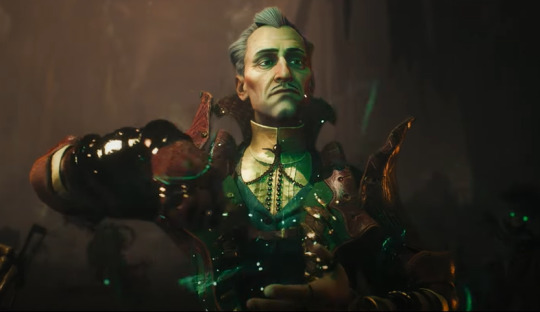
he looks like a cartoon character. the hard lines in his face, the stiffness of his hair, his overall proportions--he looks like he should be a villain in a pixar movie. like i'm digging his overall vibe and as a concept of a character design, i love it. but this execution of it next to fellow old wrinkled man varric looks so off
and then we go right into davrin who is beautifully rendered and designed--he doesn't look out of place next to varric or harding
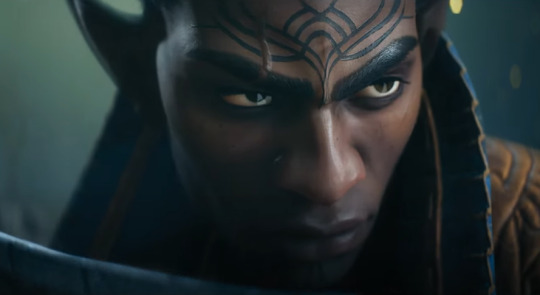
some characters have the soft, wispy hair while others have hair that looks like a hard shell with lines carve into it. some characters have finely detailed wrinkles while others have thick, cartoonish ones. some characters have realistic proportions while others have more exaggerated features.
stylization is only effective when it's purposeful and consistent, and from what i've seen so far, it's not. it's all over the place.
so there's my thesis about why i dont like the art direction in the trailer lmao
and like i've been saying since it dropped, i am reserving full judgment for the gameplay reveal, but based on the other stuff bioware has teased, i'm not expecting this aspect to change too much. i've seen other ppl who were on the fan council thing say the tone in the game is more in-line with the tone in the other games, so maybe that'll help smooth out this disconnect
33 notes
·
View notes
Text
for @iriswashername, A write up of Mingi's live on June 10, 2023.
youtube
It's dark. Why is it dark? Are you having a breakout? What is going on? Dude I'm slowly going blind in one eye - can we not do this?
There are 10,000 people (holy shit) in this chat.
We're in his work room.
He explains that he's drinking water, not anything else (i.e. it's not alcohol). I suspect that this is another flirtation or teasing attempt by the Mingi-biased, who strike me as very valiant in continuing to try to do engage him in this way, given that he just won't play. Wooyoung has drunk alcohol on lives and the 영부인 and he had a lot of fun teasing back and forth about it. But Mingi says, flatly, in monotone, It's water. The end.
He explains why he won't turn on the light. It looks too unaesthetic if he turns on the light. 어두운건 어쩔수 없어. You'll just have to deal with the dark. He doesn't apologize. He explains - he needs to buy a lamp, and this task has been on his to-do list for five months but he just hasn't done it. The overhead light is installed, yes, but it's so unacceptable that his volume goes up several decibels when describing the unacceptability: 하얀색으로 쨍~~ 해서! (it's such a braaassyyy white!). So we the viewers are just going to have to sit in the dark and understand.
There's a discussion about whether he's eating, and what he ate, and exercise. Idols are supposed to be model-thin, wraith-thin, just very slender lines. It's also a Korean cultural thing, to ask people if they ate instead of asking how they are. Long history of famines, invasions, etc, contributed to that, I'm sure.
Mingi delivers the message that he and the others have been on a variety of content shows and says looking them up should be a good time for the fans. I feel like this was on his to do list, to tell people this.
Then comes attempts by the Valiant Mingi-Biased to engage him in small talk, each of which fails so completely it starts to be comical. What games do you ilke? I don't play games. What animations do you like? I don't watch animation. Hahaha. No dice! He does politely respond with a game he's heard is popular, and an animation he's heard someone he works with likes.
He says, 이제 다들 잘 시간이죠? Why is he always sending people off to sleep, when he's the one that turned on the chat? I think this may be his way of being caring. It doesn't feel like it because it's not warm nor appeals to the emotions, but I think he really is like, I hope your fandom participation doesn't encroach on priorities in your actual life.
The World Ep 2: Outlaw is about to come out at this point in time. He says about the title song, Bouncy, that it's easy to follow, easy to do challenges with. Then he says, It fits well with the current trends in the music market. This is very striking. I haven't heard Wooyoung or Seonghwa mention this sort of business assessment of their songs.
I have recently noticed that Mingi's rap portions tend to use very, to use an American colloquialism, Four dollar words, you now, SAT Vocab prep words, that pop out at me. Turns out that he actually just talks like this. When describing how much he likes his own rap-making in This World, he says, 긴 문장은 아니지만 그 문장안에 담아있는 함축적 의미가 표현한 것. 함축적 (implication) is not a word I've ever heard an entertainer say in any interview.
He tells a little joke about the lyrics of Bouncy - he says Song Mingi is in the song itself. Bouncy has him shouting s-o-n-g-m-i-n-g-i in the lyrics, of course. That's very funny but like, it's a very long distance joke, and it isn't actually delivered like a joke.
He says that he does get recognized in the streets (of Seoul?) now (in 2023) and that it makes him happy.
Mingi says again that Bouncy is fun and easy to learn. This is his indirect way of encouraging social media engagement, perhaps.
The Valiant Mingi-Biased try again to engage in flirty, naughty talk. They ask if 청량고추 is a double entendre. Mingi again doesn't bite. This is not what he wants to talk about. 이중적이라기 보다 따라하기 쉬운, 쉽게 들을수 있는 노래. He says, Rather than a double meaning, you should know that it's easy to sing along to, and easy to listen to. It's clear by this point that Mingi thought that their songs before Bouncy were difficult for the average listener.
Mingi launches into serious mode, and again I'm struck by how literary his utterances are. He says that he didn't reveal his works in progress because he was spending the time doing this: 자신을 가꿔 왔다. Cultivating himself. He says that because he received so many expressions of love from fans, he has experienced this: 편협한 생각과 편견들이 깨지기 시작. The shattering of prejudices and narrow minded thoughts (but 편협 is elevated language. You can say 좁다, 작다, 소극적이다 which is in more common usage). He says 결과론적으로 보여줄 수 없더라도. He says 지난과 지금이 부딪혔던 순간들이 있었는데 생각의 전환점이 되어 춤 라이브를 시작했다. He says, 노력을 해서 여러 발자취를 남기면 원하는 결과를 만들어 낼수 있지 않을까. 뭔가 성대하게 보여줄 수 있다는 건 아니지만. What does this guy read or watch that gives him this vocabulary and penchant for complex sentence structures in Korean speech? SO INTERESTING. He speaks in poetic language, and it doesn't seem like's reading from a script.
Mingi does fan service talk about how his fans have helped him grown, how their love has healed him and matured him as an artist, and how apologetic he feels at not giving them 'more' and 'better' art back in return for their love. Except the way he doesn't it doesn't feel like fan service. He's taken off his hat to give this speech. It feels so genuine.
Then he puts his hat back on to say, I've been talking too seriously for too long, haven't I?
Once again, the Mingi Fans try to flirt: "Don't cry about it," and he doesn't smile or anything. I think this might be annoying actually, because he reiterates the bit about being apologetic to his loving fans because of his inability until recently to give them more content.
HongJoong calls and they are so formal with each other. HJ actually calls him 선생님. They just compliment each other, like businessmen who've launched an IPO, in a very professional way. Mingi invites HJ to visit this work room sometime, and HJ leaves by wishing (very very formally) Mingi and his fans a happy rest of chat.
Mingi-Fans strike again: Do you have a name for your workroom? No, he says. The end. HAHAHA. Wooyoung would go, What should I call it? Seonghwa would try to come up with one, something very cute. But Mingi is like, NOPE.
Then comes the song reveal. I don't think it has a title. (Later confirmed that it's actually called 무제 - Untitled). When you ask former 연습생- now Idols to write songs, they seem to come out with stuff like this. Bangchan's lyrics are often in this vein too actually. It's always from the POV of a very uncertain young person whose hopes and plans for the future frightens and hurts them because they want it so badly but the path forward is so strewn with obstacles. The world is harsh and rough and poisonous and cold. They're always alone, too - nobody to talk to, no one on their side. This song, because it's written by Mingi, says this literally: 날 도와줄 사람은 여긴 아무도 없나봐 (there's nobody here that would help me).
He hides his face the entire time this song is playing. When it's over, he doesn't solicit feedback. He just says, I made this for you, thank you for waiting, thank you and sorry.
There's only like, five things that an Idol is actually allowed to say: 감사합니다. 사랑합니다. 노력하겠습니다. 미안합니다. 사랑해주세요. Thank you. I love you. I'll try harder/ keep trying. I'm sorry. Please love us /me. He says all of these except the last one, except again, the awkwardly blunt delivery somehow makes it seem fresh and sincere.
Then he says, I came here to share the song, and since I've done that, I'm going.
Obligatory 애교 moves done in the most obligatory way, and he's gone.
Mingi Song is SO interesting.
16 notes
·
View notes
Text
Streets and Districts of Veyren City.
As the title implies here is a list of streets: residential streets, main roads, connector roads and districts! (Animated purple and white divider made by @/cafekitsune)

Ashwick Avenue - A historic ave with old buildings, dimmed streetlights, and a lingering mist.
Cinder Row - A narrow street with a mix of small businesses' and fading neon signs knowns for it's quiet timeless feel.
Vale Street - A long winding road that always seems slick with rain, lined with cafe's record shops and a teahouse that refuses to die out.
Halloway Road - A street that curves through the heart of the city, known for its mix of modern and decayed architecture
Lockewood Drive - A semi-industrial road where tech startups and small shops co-exist.
Whitmoor Street - An area known for its old-world charm, bookstores and flower shops still hold against time.

Novastra Boulevard -
Main Artery of the pulse district. Holographic billboards and glass skyscrapers tower the streets
Notable places:
Veyren Grand Station - The Cities central train hub, packed at all times.
Astrocorp HQ - A cooperate tower belonging to a mega-conglomerate that controls most of Veyren's digital infrastructure
Synthwave Café - a 24 hour coffee shop with neon lit walls and robotic baristas
Project Dome - A massive curved screen, displaying ads, weather, news, and the latest fashion trends in real time.

Orion Street -
A shopping and entertainment hub where the latest tech and fashion is sold.
Notable places:
Oblivion Club - One of the biggest night clubs in Veyren with floors that light up as people dance. The drinks are never ending as well as the friendly company.
Neon Arcade - A retro futuristic arcade where old school gaming collides with VR and newer stylistic games.
Hyper Mart 24 - A fully automated department store with robotic assistance. You think it? They got it!
Starlight Records - A hidden vinyl record shop that still exists despite the digital age

Helix Road -
A tech and business center, home to high end offices, and digital marketing firms.
Notable Places:
Zephyr Towers - A sleek black skyscraper that's a hub for cyber security firm.
Neurolink Labs - A company experimenting with brain-interface technology.
Flux Lounge - High end, invite only social club where executives discuss business over cocktails.
Astra Bar - A bar with digital bartenders and waiters and drinks that glow under blacklight

Stratos Avenue -
Known for media, fashion, and high energy night life.
Notable places:
Veyren Broadcast Center - the city's largest media headquarters, airing new and digital influencers.
Runway 99 - An avant-garde fashion district where models walk beside holograms of the fashions creators.
Pulse plaza - A futuristic square where massive events take place and ads are projected into the skies.
The Grid - A rooftop lounge balcony with a stunning view of the cities skyline.

Synapse Alley -
A gritty underground area filled with hidden bars, black market tech, and cybernetic enhancement shops.
Notable Places:
Echo Bar - A secret jazz bar that Tristan visits from time to time. The only semi-safe place in the alley.
Bytes & Bites - A hacker café where people don't just sell coffee, they sell digital secrets.
The Raven Room - A speakeasy accessible only through a glitched billboard. Where people drank and talked shop over the latest illegal tech.
PawnXchange - A pawn shop for illegal tech, and stolen data drives.


Rainmere Street - A quiet hidden street, nothing to spectacular there home to three story walk ups.
Halloway Lane - A lesser known street where only locals wander, known for its "old world feel"
Wrenford Alley - old abandoned shops with swinging wooden signs and cobblestone road. A relic from the older days.
Bellrose Street - Home to Tristan and his bookshop~!
Dunhaven Street - Home to a small park with a pond and a playground, really only the "natural green" around these days without leaving the city.
Draycott Lane - A small street lined with homes and a few antique and second hand shops.

Easton Bridge - Pedestrian/vehicle bridge leading from the Pulse District to the residential district.
Lennox Street - A bustling road lined with chain food restaurants.
Verity Square - A plaza full of street vendors leads to Synapse alley.
Halloway Underpass - A tunnel beneath the train station where rain water pools beneath flickering lights. Leads to Holloway Road.
6 notes
·
View notes
Text
Hi, idk who's going to see this post or whatnot, but I had a lot of thoughts on a post I reblogged about AI that started to veer off the specific topic of the post, so I wanted to make my own.
Some background on me: I studied Psychology and Computer Science in college several years ago, with an interdisciplinary minor called Cognitive Science that joined the two with philosophy, linguistics, and multiple other fields. The core concept was to study human thinking and learning and its similarities to computer logic, and thus the courses I took touched frequently on learning algorithms, or "AI". This was of course before it became the successor to bitcoin as the next energy hungry grift, to be clear. Since then I've kept up on the topic, and coincidentally, my partner has gone into freelance data model training and correction. So while I'm not an expert, I have a LOT of thoughts on the current issue of AI.
I'll start off by saying that AI isn't a brand new technology, it, more properly known as learning algorithms, has been around in the linguistics, stats, biotech, and computer science worlds for over a decade or two. However, pre-ChatGPT learning algorithms were ground-up designed tools specialized for individual purposes, trained on a very specific data set, to make it as accurate to one thing as possible. Some time ago, data scientists found out that if you have a large enough data set on one specific kind of information, you can get a learning algorithm to become REALLY good at that one thing by giving it lots of feedback on right vs wrong answers. Right and wrong answers are nearly binary, which is exactly how computers are coded, so by implementing the psychological method of operant conditioning, reward and punishment, you can teach a program how to identify and replicate things with incredible accuracy. That's what makes it a good tool.
And a good tool it was and still is. Reverse image search? Learning algorithm based. Complex relationship analysis between words used in the study of language? Often uses learning algorithms to model relationships. Simulations of extinct animal movements and behaviors? Learning algorithms trained on anatomy and physics. So many features of modern technology and science either implement learning algorithms directly into the function or utilize information obtained with the help of complex computer algorithms.
But a tool in the hand of a craftsman can be a weapon in the hand of a murderer. Facial recognition software, drone targeting systems, multiple features of advanced surveillance tech in the world are learning algorithm trained. And even outside of authoritarian violence, learning algorithms in the hands of get-rich-quick minded Silicon Valley tech bro business majors can be used extremely unethically. All AI art programs that exist right now are trained from illegally sourced art scraped from the web, and ChatGPT (and similar derived models) is trained on millions of unconsenting authors' works, be they professional, academic, or personal writing. To people in countries targeted by the US War Machine and artists the world over, these unethical uses of this technology are a major threat.
Further, it's well known now that AI art and especially ChatGPT are MAJOR power-hogs. This, however, is not inherent to learning algorithms / AI, but is rather a product of the size, runtime, and inefficiency of these models. While I don't know much about the efficiency issues of AI "art" programs, as I haven't used any since the days of "imaginary horses" trended and the software was contained to a university server room with a limited training set, I do know that ChatGPT is internally bloated to all hell. Remember what I said about specialization earlier? ChatGPT throws that out the window. Because they want to market ChatGPT as being able to do anything, the people running the model just cram it with as much as they can get their hands on, and yes, much of that is just scraped from the web without the knowledge or consent of those who have published it. So rather than being really good at one thing, the owners of ChatGPT want it to be infinitely good, infinitely knowledgeable, and infinitely running. So the algorithm is never shut off, it's constantly taking inputs and processing outputs with a neural network of unnecessary size.
Now this part is probably going to be controversial, but I genuinely do not care if you use ChatGPT, in specific use cases. I'll get to why in a moment, but first let me clarify what use cases. It is never ethical to use ChatGPT to write papers or published fiction (be it for profit or not); this is why I also fullstop oppose the use of publicly available gen AI in making "art". I say publicly available because, going back to my statement on specific models made for single project use, lighting, shading, and special effects in many 3D animated productions use specially trained learning algorithms to achieve the complex results seen in the finished production. Famously, the Spider-verse films use a specially trained in-house AI to replicate the exact look of comic book shading, using ethically sources examples to build a training set from the ground up, the unfortunately-now-old-fashioned way. The issue with gen AI in written and visual art is that the publicly available, always online algorithms are unethically designed and unethically run, because the decision makers behind them are not restricted enough by laws in place.
So that actually leads into why I don't give a shit if you use ChatGPT if you're not using it as a plagiarism machine. Fact of the matter is, there is no way ChatGPT is going to crumble until legislation comes into effect that illegalizes and cracks down on its practices. The public, free userbase worldwide is such a drop in the bucket of its serverload compared to the real way ChatGPT stays afloat: licensing its models to businesses with monthly subscriptions. I mean this sincerely, based on what little I can find about ChatGPT's corporate subscription model, THAT is the actual lifeline keeping it running the way it is. Individual visitor traffic worldwide could suddenly stop overnight and wouldn't affect ChatGPT's bottom line. So I don't care if you, I, or anyone else uses the website because until the US or EU governments act to explicitly ban ChatGPT and other gen AI business' shady practices, they are all only going to continue to stick around profit from big business contracts. So long as you do not give them money or sing their praises, you aren't doing any actual harm.
If you do insist on using ChatGPT after everything I've said, here's some advice I've gathered from testing the algorithm to avoid misinformation:
If you feel you must use it as a sounding board for figuring out personal mental or physical health problems like I've seen some people doing when they can't afford actual help, do not approach it conversationally in the first person. Speak in the third person as if you are talking about someone else entirely, and exclusively note factual information on observations, symptoms, and diagnoses. This is because where ChatGPT draws its information from depends on the style of writing provided. If you try to be as dry and clinical as possible, and request links to studies, you should get dry and clinical information in return. This approach also serves to divorce yourself mentally from the information discussed, making it less likely you'll latch onto anything. Speaking casually will likely target unprofessional sources.
Do not ask for citations, ask for links to relevant articles. ChatGPT is capable of generating links to actual websites in its database, but if asked to provide citations, it will replicate the structure of academic citations, and will very likely hallucinate at least one piece of information. It also does not help that these citations also will often be for papers not publicly available and will not include links.
ChatGPT is at its core a language association and logical analysis software, so naturally its best purposes are for analyzing written works for tone, summarizing information, and providing examples of programming. It's partially coded in python, so examples of Python and Java code I've tested come out 100% accurate. Complex Google Sheets formulas however are often finicky, as it often struggles with proper nesting orders of formulas.
Expanding off of that, if you think of the software as an input-output machine, you will get best results. Problems that do not have clear input information or clear solutions, such as open ended questions, will often net inconsistent and errant results.
Commands are better than questions when it comes to asking it to do something. If you think of it like programming, then it will respond like programming most of the time.
Most of all, do not engage it as a person. It's not a person, it's just an algorithm that is trained to mimic speech and is coded to respond in courteous, subservient responses. The less you try and get social interaction out of ChatGPT, the less likely it will be to just make shit up because it sounds right.
Anyway, TL;DR:
AI is just a tool and nothing more at its core. It is not synonymous with its worse uses, and is not going to disappear. Its worst offenders will not fold or change until legislation cracks down on it, and we, the majority users of the internet, are not its primary consumer. Use of AI to substitute art (written and visual) with blended up art of others is abhorrent, but use of a freely available algorithm for personal analyticsl use is relatively harmless so long as you aren't paying them.
We need to urge legislators the world over to crack down on the methods these companies are using to obtain their training data, but at the same time people need to understand that this technology IS useful and both can and has been used for good. I urge people to understand that learning algorithms are not one and the same with theft just because the biggest ones available to the public have widely used theft to cut corners. So long as computers continue to exist, algorithmic problem-solving and generative algorithms are going to continue to exist as they are the logical conclusion of increasingly complex computer systems. Let's just make sure the future of the technology is not defined by the way things are now.
#kanguin original#ai#gen ai#generative algorithms#learning algorithms#llm#large language model#long post
5 notes
·
View notes
Text
Fashion Forecasting: Summer Trends to Expect in 2025
With Spring just around the corner, it is to be expected that both Highstreet and online retailers will begin to bring a glimpse of predicted summer trends.
Some trends have stayed for the 2025 season, such as the ‘70s inspired ‘boho’ style, which takes inspiration from brands such as Chloé, with the incorporation of sheer, beaded fabrics, platform shoes and studded accessories. Materials such as suede have been a popular choice amongst celebrities, furthermore with a surge in searches for suede bags along with suede accessories, a trend cycle that is predicted to be strong through to A/W 2025.
Popular colours this spring with Easter quickly approaching is a lighter pink along with pistachio. The powdery pink has been seen on the runway by the likes of Miu Miu and of course Chanel, who often lean into the feminine gaze with their often use of airy, light colours and jewelled accessories.
Pistachio, and other lighter green shades have also become popular, possibly from the influence of Cynthia Erivo’s iconic green character ‘Elphaba’, from the film adaptation of ‘Wicked.’ Other celebrities such as Kaia Gerber along with Elle Fanning have also been seen sporting the colour along the red carpet.

Another summer staple seen rocking the runway is hot pants, particularly those made from knitted fabrics or even denim. Gen Z consumers are pairing the hot pants with another trending item, lace or colourful stockings, which have also had a resurgence in the last twelve months.
Sportswear variations are also gaining popularity by being styled in different manners, particularly sweatpants along with yoga style sportswear being styled in both a casual and dressed up manners, sometimes paired with heels, to give a ‘model off duty’ look.
Animal prints, especially leopard and zebra prints are expected to continue to dominate the market in 2025, with the commercial success of leopard print bottoms/jeans in 2024. Snakeskin is also predicted to be a popular choice as well.
Other things to consider about fashion in 2025 is the use of sustainable materials and practices. Many designers are using deadstock materials and even repair workshops. Brands like Aiayu, based in Copenhagen, are teaching customers how to mend and personalise their own clothes to be adapted for longer use.
Tolu Coker, a designer based in London only uses garment manufacturing and sampling within a five-mile radius and often works with deadstock material. Coker has also been known to work with handcrafted materials from Ghana and Nigeria where she has family ties.

2 notes
·
View notes
Text
The Research Begins
So essentially, I have three ideas. Two of them exist in a similar sphere and have some relation to each other, while the third is completely different and arguably more limited on the conceptual level. But I think they're all worth exploring anyway, so let's get into it. 1. Event Planning. This is the outlier of these topics, and the one with the most solid Form potential from the jump. I'm involved in Castle Point Anime Convention, and that sort of event planning is one of my favorite activities. The logistics of putting such an event together are fun to consider, and there's always something new to consider or focus on. The type of venue, the types of vendors or guests, the types of attendees we'll be catering to and what kind of activities they'll want, how to get around things like distance limitations, food options, space limitations and how to get around those, security and medical information, the list truly goes on (https://www.socialtables.com/blog/event-planning/how-to-get-logistics-right/). Then there are other considerations such as how to comfort paying customers when they worry things may not be going to plan-- good PR and polite lying are crucial for event planning. In general, there are a lot of interesting things to consider with this topic, but not many unique directions to take it.
2. Makeup. Why do different makeup looks look different? Why do different countries have such different ones? Why are certain makeup looks considered more socially acceptable than others when the only difference is color or sparkle? Why is it only acceptable for some people to wear makeup? And when people that aren't them wear it, who decides what styles are acceptable? Why is that where the line is drawn? There are so many questions and not that many answers when it comes to this topic. I'm particularly interested in the differences between different makeup styles across different countries and cultures. As an example, Japanese eye makeup (https://www.tumblr.com/asian-makeup/177452951954/japanese-eyes-makeup) vs Korean eye makeup vs Chinese eye makeup vs the typical American eye makeup look.



Makeup as a general tool for self-expression and by extension for gender nonconforming purposes is also an interesting subject, with things like drag makeup existing in its own space, and men's makeup becoming an increasingly feasible market (https://www.forbes.com/sites/dahvishira/2024/03/06/makeup-is-more-than-a-trend-for-men-its-a-rapidly-rising-market/). Graphic makeup styles and similarly artistic and over-the-top styles are super interesting to me, too. These sorts of style also play into some really interesting fashion subcultures like Gyaru, Decora, and China's Dopamine Girls.

3. Gender-neutral fashion. Fashion as expression is super interesting to me and I love looking into different subcultures and their rules, but one thing I've noticed seems to have no rules is gender-neutral fashion. I largely believe this is because in the fashion world, "gender neutral" is equal to masculine or masculine presenting. A quick Google of "gender-neutral fashion" yields dozens of pictures of tall, thin models with good proportions and no real curves or unavoidable secondary sex characteristics wearing largely masculine clothing silhouettes. The occasional masc model in a sweetheart neckline or skinny jeans pops up, or a prominent LGBT celebrity wearing a dress to an event everyone would expect a suit. Otherwise, staples like dresses, skirts (particularly anything shorter than knee-length), and even crop tops are almost entirely left out in favor of blazers, slacks, loose-fitting t-shirts and sweatshirts, baggy jeans, and oversized cardigans. Generally, a lot of the more obviously feminine or revealing clothing is seemingly relegated to femme-presenting models as well. The idea that only men's clothing is gender-neutral is fascinating to me, as someone who likes dressing both ways and exploring these things in other cultures is also really interesting. Different cultural standards lead to different ideas of gendered and gender-neutral fashion, and that's also something worth exploring further. Social expectations, the idea of gender-neutral as a concept, male as default, the fashion industry, I think it's all worth considering and researching further going forward.

4 notes
·
View notes
Text
i found this ramble in my drafts from february and it makes some reference to dated news but I wanna post it anyway bc nothing has changed about the issue itself
it really baffles me how dndbeyond does cosmetics.
there's a whole host of currently existing options - varying theme colours, pretty artwork to make your background, cool frames for your character profile! i play with all of these on my character sheets, and they're funky, really help you personalise your sheets and connect them to your characters!!
the main problem? the *only* way you can get a majority of the cosmetics is through pre-ordering books. now, pre-order bonuses are a good marketing strategy, sure, and with pre-order bonuses comes the nececcity for those bonuses to be exclusive. but when those cosmetics are a big majority of those that exist? you have a problem.
on a whole, of course i dislike the overall sentiment behind Cynthia Williams' notion that dnd is 'under monetized' - and the whole money-hungry mess that things have seemed with wotc lately. yet, i think in this specific matter i actually agree that it's a shame players don't have many options to spend money on the game. but...maybe let's give them some reasonable ones?
i am a DM, and have, as per Williams' observations, probably spent more on the game than the average non-DM. wotc can care about that discrepancy, but i really dont. what i do care about is that i am also a player and i *want* to be able to also spend on player things - like making my sheets look cool! and i actively cannot! in fact, the cosmetics i do own are primarily from pre-ordered books (some kindly gifted!) that i had interest in because i was a DM! it's not worth as a player it to pre-order a book you won't use for only the pre-order bonuses, and though a DM can awkwardly share those bonuses with their players, currently the only primary way players can get cosmetics is the few unpredictable monthly reward of a subscription. and we'll get back to those.
another downside to the pre-order bonus model? how fucking specific those cosmetics are - and i move to focus primarily on the frames here. they're of course themed to the books, but so often in a way that makes me wonder how few characters these would really fit the sheets of.
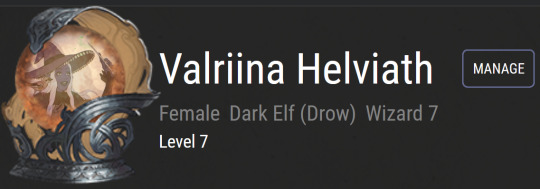

here are some frames from the Tasha's and Ravenlost pre-orders. the art is nice enough but...who wants these? i dont want these.
to get back to the subscriber frames, one might expect these to offer the more universal range of options. there are a couple nice vague frames, but the very few options are, once again, largely very specific, as season-themed frames. the subscriber frames include such all-applicable options as these.


you'll also notice a trend of heavily obscuring the character portrait itself (most obvious with my first two examples, and i promise there are other similar instances). overall it's just...frustrating that it's so difficult to find a frame that actually fits a character, nor obscures them beyond readability.
for so long, I've been baffled at the lack of a cosmetics shop where one can buy generic and specific frames for pocket change. It seems so obvious, and hardly outside dndbeyond's current setup. give me leafy frames for naturey characters, music note frames for musicians! frames themed after signature spells - magic missile, mage hand, crown of stars. frames designed after the types of damage, after different subclasses, after different weapons! frames with varying levels of complexity - both simple designs that can just match a character's colour scheme, and detailed animated frames!
when we got these frames, and I was estatic! It really seemed like a step in the right direction with simple, useable, non-obscuring frames. they're great!
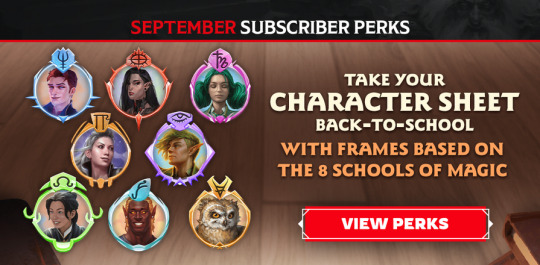
but since, though frames have gotten a little better in readability and specificity, we see no indication towards any change. occasionally, a book like the wildemount book will have some lovely generic frames, but then then the subscriber rewards are right back to weird and specific. can only keep fingers crossed, i suppose.
10 notes
·
View notes